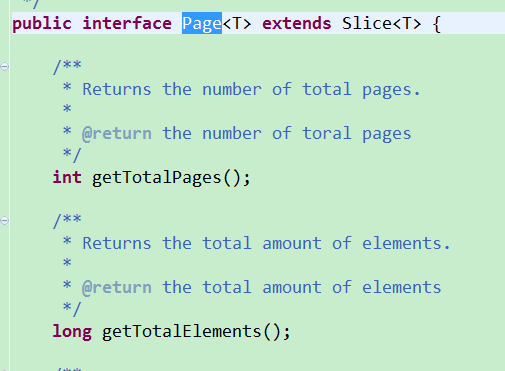分页原理

左边的数字是表示每页的显示条数,可以自由选择,如果一共有100条数据,选择10就代表每页显示10条,一共有10页,选择其它数字则依次类推。 可以在创建datagrid控件的时候,设置属性 :pageList: [30,50,100], 通过抓包工具抓取数据如下: 第一次加载查看请求的json数据:

请求第二页请求的数据:

分析:page表示页码,rows表示 每页需要记录条数 由上可知,前端可以通过向后端传入page和rows向后端请求分页的数据,而服务器要根据请求参数page和rows查询分页数据,并且以标准格式返回。 返回的格式就是:
{
total: 总记录数,
rows: [ //当前页数据
{*************},
{**************}
]
}
请求数据:page 页码,rows 每页记录数 响应数据: total 总记录数 , rows 当前页数据记录数
编写服务器代码实现分页查询
后端技术: maven+struts2+spring+spring data jpa
- 修改数据表格的url:
$('#grid').datagrid( {
iconCls : 'icon-forward',
fit : true,
border : false,
rownumbers : true,
striped : true,
pageList: [30,50,100],
pagination : true,
toolbar : toolbar,
url : "../../standard_pageQuery.action",
idField : 'id',
columns : columns
});
- 在action中添加分页查询的方法 页面会自动发送;两个请求的参数:page 页码 rows 每页记录数
action代码的编写:
/**
* 因为要返回total和rows
* 最开始的思路是分别写方法查询
*/
//1.调用业务层,查询总记录数
long total = standardService.findTotal();
//2.调用业务层,查询当前页的数据
List<Standard> standards = standardService.findPageData();
_ 在查询当前页数据的时候遇到问题,到底是分别传参呢还是把封装后再传?_ 最终要考虑的是spring data 到底如何做分页? 因为spring data jpa 的父接口是Repository, 则查看Repository的源码:
public interface Repository<T, ID extends Serializable>
查看继承树可以看到有个:PagingAndSortingRepository<T, ID >
@NoRepositoryBean
public interface PagingAndSortingRepository<T, ID extends Serializable> extends CrudRepository<T, ID> {
/**
* Returns all entities sorted by the given options.
*
* @param sort
* @return all entities sorted by the given options
*/
Iterable<T> findAll(Sort sort);
/**
* Returns a {@link Page} of entities meeting the paging restriction provided in the {@code Pageable} object.
*
* @param pageable
* @return a page of entities
*/
Page<T> findAll(Pageable pageable);
}
**由上可知,spring data jpa 提供了分页查询的方法,接受pageable的参数,那么问题来了,到底什么是pageable呢?要如何来实现? ** 查看源码可是pageable是一个接口,查看实现类

spring data 提供PageRequest对象,实现Pageable接口,源码如下
public PageRequest(int page, int size) {
this(page, size, null);
}
由上面的分析可知:我们只要创建一个Pageable的对象即可。

因为Page<T>已经实现了封装总记录数,和每页记录的数据,就不需要再单独写方法去查询总的记录数了。
代码如下:
//调用业务层,查询分页信息
Pageable pageable = new PageRequest(page-1,rows);
Page<Standard> pageData = standardService.findPageData(pageable);
注意:因为在PageRequest的实现中,page参数是从0开始的,因为我们传入的参数要:page-1

业务层代码:
public interface StandaredService {
Page<Standard> findPageData(Pageable pageable);
}
业务层实现:
@Service
@Transactional
public class StandardServiceImpl implements StandaredService {
//注入Dao层
@Autowired
private StandardRepository standardRepository;
@Override
public Page<Standard> findPageData(Pageable pageable) {
return standardRepository.findAll(pageable);
}
}
因为方法是spring data jpa自带的,不需要写DAO层代码
将数据转为json,有很多种方法,简单起见,这里直接使用spring自带的 struts2-json-plugin
在pom.xml中导入json插件:
<dependency>
<groupId>org.apache.struts</groupId>
<artifactId>struts2-json-plugin</artifactId>
<version>${struts2.version}</version>
</dependency>
struts2-json-plugin用法:默认的是把ValueStack 顶部的对象转为json返回 因此,只需要把要返回前台的是数据压入值栈即可。
// 将map转换为json数据返回 使用struts2-json-plugin插件
ActionContext.getContext().getValueStack().push(result);

在struts-json-plugin配置,有result-type,要实现type=“json”,类就要去继承json-default这个包
action代码:
@Controller
@ParentPackage("json-default")
@Namespace("/")
@Scope("prototype")
public class StandradAction extends ActionSupport {
//调用Service层
@Autowired
private StandaredService standardService;
//属性驱动
private Integer page;
private Integer rows;
public void setPage(Integer page) {
this.page = page;
}
public void setRows(Integer rows) {
this.rows = rows;
}
@Action(value="standard_pageQuery",
results={@Result(name="success",type="json")})
public String pageQuery(){
//调用业务层,查询分页数据结果
Pageable pageable = new PageRequest(page-1,rows);
Page<Standard> pageData = standardService.findPageData(pageable);
// 返回客户端数据需要total和rows
Map<String,Object> result = new HashMap<String,Object>();
result.put("total", pageData.getNumberOfElements());
result.put("rows", pageData.getContent());
// 将map转换为json数据返回 使用struts2-json-plugin插件
ActionContext.getContext().getValueStack().push(result);
return SUCCESS;
}
}























 211
211

 被折叠的 条评论
为什么被折叠?
被折叠的 条评论
为什么被折叠?








